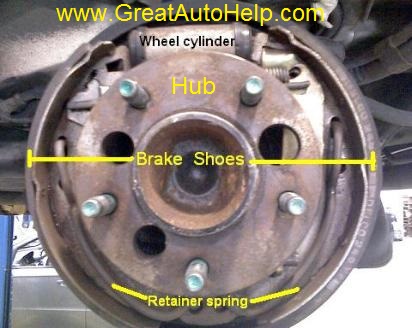Rear Drum Brake Description

Brake Fluid is forced into the wheel cylinder, which pushes the brake shoes out so that the friction of the shoe linings against the drum causes the wheel to stop.
The friction surfaces of the shoes on a drum brake convert the forward motion of the car or truck into heat. Heat and friction of the shoe linings causes the material to wear out. This is what gives the dust in the drum when it is removed. Eventually the shoe linings will wear out and require replacement.
Regular periodic maintenance of removing the drums, cleaning the dust, and adjusting the shoes will give longer life to the brake shoes and the front brake pads. Very dusty and mis adjusted rear brakes can cause premature wear of the rear shoes, poor stopping ability, and a heavier load on the front brakes, causing front pads to wear out quicker as well.

A problem that happens with rear drum brakes is a noise in the rear of your car or truck when braking. This usually happens for the first few brake applies in the morning or when the weather outside is damp. This causes the dust to sort of clump up and can cause a scraping sound from the rear of the vehicle. It will go away after a couple of stops. If you hear that, make sure to get them inspected.
Brake pulsation is another common problem. When stopping you may feel the car pulsing. This is caused by a warped front rotor or rear drum. The best way to determine which, is to remember this rule of thumb- if the problem is a bouncing feeling in the peal more than the whole vehicle itself, then the rear has a warped brake drum. Resurfacing or replacement would be required.

Click picture for a Closer view of adjusting.


